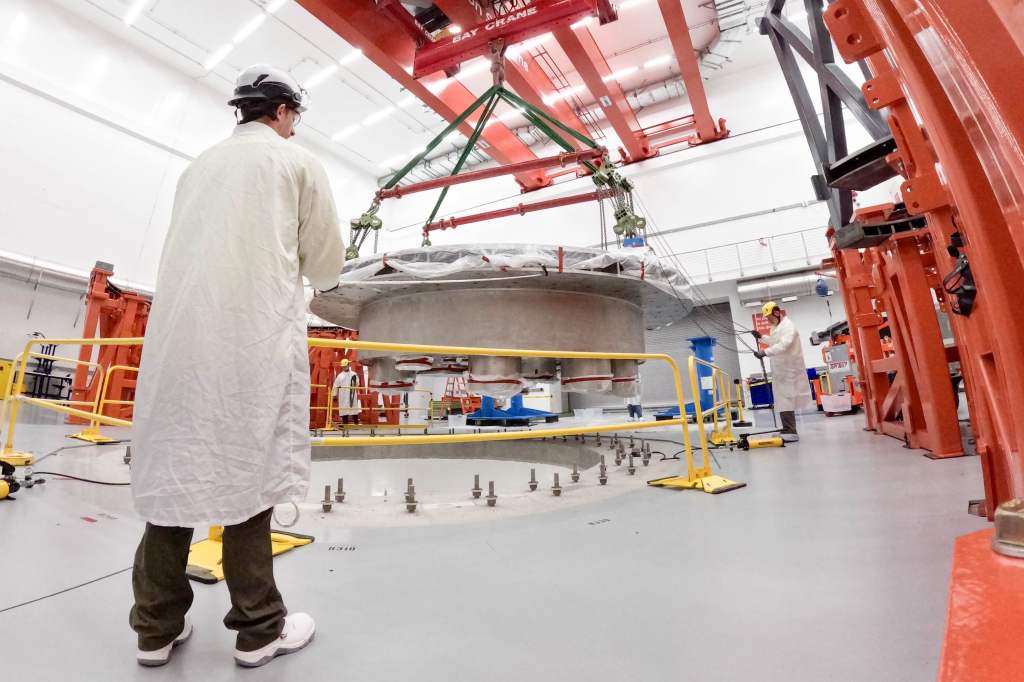Commonwealth Fusion Systems (CFS), a leader in fusion energy technology, has reached a significant milestone in the construction of its SPARC demonstration reactor. The company announced the successful installation of the cryostat base, a critical component of the tokamak—the doughnut-shaped core of the fusion reactor. This 24-foot-wide, 75-ton stainless steel structure, manufactured in Italy, was transported to CFS’s facility in Devens, Massachusetts, marking a pivotal step in the assembly of the fusion machine.
Alex Creely, Director of Tokamak Operations at CFS, emphasized the importance of this development, stating, “It is the first piece of the actual fusion machine.” He highlighted the transition from building the industrial facility to constructing the tokamak itself, underscoring the project’s progression.
CFS is among several startups striving to harness fusion power, a process that promises to deliver vast amounts of clean energy by fusing hydrogen atoms derived from seawater. The potential of fusion energy is immense, offering a sustainable solution to meet the world’s growing electricity demands, especially with the increasing prevalence of electric vehicles and data centers.
Backed by prominent investors, including Bill Gates’s Breakthrough Energy Ventures, CFS is considered a frontrunner in demonstrating the commercial viability of fusion energy. In December 2024, the company announced plans to build its first commercial-scale reactor, named ARC, in Chesterfield County, Virginia. This plant is expected to generate approximately 400 megawatts of carbon-free electricity, sufficient to power about 150,000 homes, and is slated to come online in the early 2030s.
The SPARC reactor, currently under construction, is anticipated to achieve its first plasma in 2026 and net fusion energy shortly thereafter. If successful, SPARC could become the first tokamak to produce more energy than it consumes, a milestone known as “net energy gain.” This achievement would pave the way for the ARC power plant, positioning the United States at the forefront of fusion energy development.
Fusion energy has long been pursued as a clean and virtually limitless power source. Unlike traditional nuclear reactors that rely on fission, fusion combines light atomic nuclei to form heavier ones, releasing energy in the process. This reaction powers the sun and stars, and replicating it on Earth has been a scientific goal for decades.
The tokamak design employed by CFS uses powerful superconducting magnets to confine and compress plasma at temperatures exceeding 100 million degrees Celsius, conditions necessary for fusion to occur. These magnets must be cooled to -253 degrees Celsius using liquid helium. The cryostat base plays a crucial role in maintaining these low temperatures by insulating the magnets from ambient conditions, functioning similarly to the bottom of a thermos.
The installation of the cryostat base involved meticulous planning and execution. Upon arrival, the CFS team spent several days unpacking and inspecting the component to ensure it remained undamaged during transit. This careful approach reflects the precision required in assembling a fusion reactor, where each component’s integrity is vital to the system’s overall performance.
CFS’s progress is part of a broader movement toward realizing fusion energy’s potential. In June 2024, the company signed a $15 million agreement with the U.S. Department of Energy (DOE) under the Milestone-Based Fusion Development Program. This initiative aims to accelerate the development of fusion technology and establish U.S. leadership in this emerging field. The program’s structure, which releases funding upon achieving specific milestones, ensures that taxpayer dollars are effectively utilized while encouraging private investment.
The DOE’s support aligns with the administration’s Bold Decadal Vision for Commercial Fusion Energy, aiming to bring fusion power to the grid within the next decade. This vision recognizes fusion’s role in achieving net-zero carbon emissions by 2050 and addressing the climate crisis.
CFS’s journey began as a spinout from MIT’s Plasma Science and Fusion Center in 2018. The company has since attracted over $2 billion in funding and assembled a team of experts in fusion science, engineering, and manufacturing. Their approach combines decades of research with innovative high-temperature superconducting magnet technology, enabling the development of compact and cost-effective fusion power plants.
In February 2023, CFS inaugurated its new campus in Devens, Massachusetts, encompassing corporate headquarters, an advanced manufacturing facility, and the SPARC facility. This campus serves as the hub for developing and deploying commercial fusion energy, bringing together the necessary resources and expertise to transition fusion science from the laboratory to the marketplace.
The opening ceremony featured notable figures, including U.S. Secretary of Energy Jennifer M. Granholm, U.S. Senators Elizabeth Warren and Edward Markey, and Massachusetts Lieutenant Governor Kim Driscoll. Secretary Granholm highlighted Massachusetts’s history of innovation and expressed optimism about CFS’s contributions to the clean energy revolution.
As CFS continues to advance its SPARC project, the successful installation of the cryostat base signifies a tangible step toward demonstrating fusion energy’s feasibility. The company’s efforts contribute to a global endeavor to develop a sustainable and abundant energy source, potentially transforming the energy landscape and mitigating climate change.
The path to commercial fusion energy is complex and requires overcoming significant scientific and engineering challenges. However, milestones like the cryostat base installation bring the vision of fusion power closer to reality. With continued support from government initiatives, private investment, and scientific collaboration, fusion energy holds the promise of providing a clean, safe, and virtually limitless power source for future generations.



